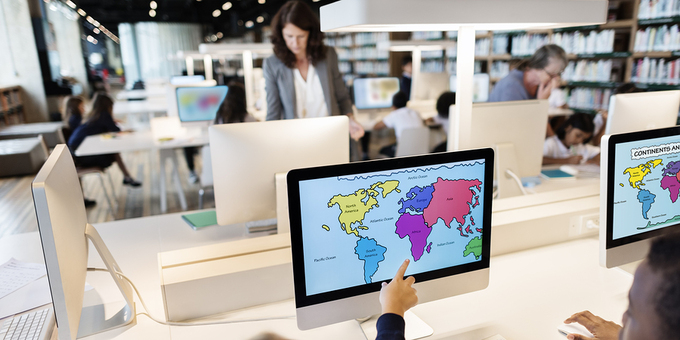

In the current high-stakes testing atmosphere in the US, assessments often get a bad name. “Teaching to the test” is a common phrase used to describe how teachers feel when their only goal is to prepare students for standardized assessments. When assessments are viewed from this perspective, it’s understandable why they can be perceived negatively.
However, it’s important to remember that student assessments can also be highly beneficial for both students and teachers, particularly when used in ways that move beyond traditional standardized tests.
When used in innovative ways, assessments can help teachers better gauge student understanding, and uncover any gaps in learning that might exist. This information can then be used to adjust instruction moving forward, leading to lessons that are more aligned with individual student needs.
However, designing and implementing these types of innovative, beneficial assessments often involves a switch in mindset away from traditional modes of standardized assessment.
As described by the U.S. Department of Education, beneficial assessments are those that “support learning and promote equity, and [are used] to measure progress and improve outcomes for our nation’s students.”
The Department of Education goes on to list 7 criteria for beneficial assessments as the goal that teachers and schools should strive for:
- “Worth taking
- High Quality
- Time-limited
- Fair – and supportive of fairness – in equity in educational opportunity
- Fully transparent to students and parents
- Just one of multiple measures
- Tied to improved learning”
While these criteria are certainly important to meet when designing assessments, it’s also important for teachers to keep in mind that assessments should be engaging for their students. When assessments are engaging for students, and meet the criteria above, teachers are better able to collect meaningful and accurate data on student progress and understanding.
Assessment Data in the Classroom
Classroom assessment data comes in all shapes and sizes. And generally speaking, assessments can be broken down into two categories: formative and summative.
Summative assessments are usually given at the end of a lesson or unit in order to determine if students reached the big picture learning goals, or success criteria, for a particular unit. An example would be a unit test or a final presentation.
Formative assessments are those that are given throughout the learning journey, and they are used to measure progress, growth, and current understanding. Examples of formative assessments include discussions, quizzes, one-on-one conversations, and anything that allows a teacher to check-in on how a student is currently doing in relation to the content.
For both types of assessments, there is enormous variety in terms of how the assessment can be delivered and what types of data can be collected.
Students can answer multiple choice questions, write reflections, perform a task, create a product, lead a discussion, document a procedure, complete a graphic organizer, and/or anything else that provides the teacher with insight into their understanding of a concept or idea.
Delivery methods for assessments are just as varied. Students can complete assessments with paper and pencil, orally, or through the use of technology.

In short, there’s no limit to how teachers can deliver assessments, or the types of data they can collect.
With all these different types of assessment possibilities, teachers should keep in mind that the core importance of any assessment is to measure student progress towards, or understanding of, the success criteria for the lesson. Success criteria are those specific learning goals that students should reach over the course of a lesson. Assessments that lack this focus tend to fail to meet the “worth taking” criteria described above.
In addition to designing assessments that are aligned with success criteria, it’s also important for teachers to find a way to collect and organize the wide variety of assessment data they collect over the course of a lesson or unit.
This is often where technology can be of assistance. Electronic grade books have made the collection and organization of numerical assessment data much easier. However, what about assessment feedback that isn’t just a number or a score?
Fortunately, teacher tools like Nearpod can facilitate the collection of assessment data like this and can help keep this data organized over time. In Nearpod, assessment data collected through quizzes, polls, and open-ended questions is stored and organized by lesson and by individual students. This data can be used at any time to generate reports and provide teachers with instant insight into student performance.
Student Assessment Tools to Increase Student Engagement
While a variety of assessment options exist, not all assessments are created equally. As discussed above, assessments should be high in quality, worth taking, and tied to improved learning. Additionally, when teachers create assessments that are also engaging for students, it is more likely that meaningful, high-quality assessment data can be collected.
Fortunately, there are numerous teacher tools and strategies that can be used to create engaging assessments and break away from more traditional standardized, multiple choice tests.
For example, Lee Watanabe-Crockett, author of Mindful Assessment, offers a variety of suggestions in his post at the Global Digital Citizen Foundation:
- “Quick summaries
- Open-ended questions
- Student interview
- Daily learning journals
- Peer teaching
- Quick-draw showdown
- Self-grading”
These types of assessments can be used not only to collect valuable information on student progress and understanding, but can also be used to help increase engagement by being more interactive, reflective, and thought-provoking compared to traditional assessments.
For example, the daily learning journals mentioned above can be used to ask students to reflect on their learning experiences either through written journals or by recording digital logs. This way, regardless of the medium, students are still engaged in the process, and teachers can use those formative assessment reflections to better understand their students’ learning experiences. Lee Watanabe-Crockett explains:
“This is a daily brief reflection exercise. It lets students privatize their experiences in their own words on a personal level. As far as assessment tools go, this is one that some students may resist. Some may not enjoy writing daily reflections. If so, offer up some alternatives. They could do it using screencasting or simple audio recording if they wish. Younger students can create vision boards or collages, relating imagery to what they’ve learned. They may also choose to share their excerpts on a class blog or web page.”
In short, the use of these types of innovative formative assessments during a lesson is a great strategy that can help teachers increase student engagement. Plus, research suggests that increased student engagement can also lead to increased achievement.
For teachers looking to increase engagement further, digital tools like Nearpod can be beneficial. With Nearpod, teachers can send out quizzes, polls, open-ended questions, and Collaborate! boards to engage students in digital discussions. All of these options can instantly collect assessment data from any student with a device and an internet connection. Plus, teachers can include images and videos within the assessments, to help boost student engagement further.
Learning from Student Assessments
While creating engaging assessments can help provide teachers with more meaningful assessment data, it’s important that teachers spend time examining assessment data once it has been collected.
Student assessment data can help teachers understand if students are on track, or if misconceptions are forming that may need to be addressed. Students can also use their own assessment data to reflect on their learning processes.
Outside of the classroom, student assessment data can provide administrators and school leaders with an understanding of how schoolwide policies and initiatives are impacting learning across the building or district.
Expanding on this idea, the National Association of Elementary School Principals offers 5 recommendations for how assessment data can be used to improve student learning and teacher practices:
- “Make data part of the ongoing cycle of instructional improvement;
- Teach students to examine their own data and set learning goals;
- Establish a clear vision for schoolwide data use;
- Provide supports that foster a data driven culture within the school;
- Develop and maintain a districtwide data system.”
Overall, students, teachers, and administrators can all benefit from student assessment data. Students can learn from past experiences and mistakes, teachers can determine where adjustments to instruction need to be made, and administrators can see the impact that schoolwide policies are having on student achievement.
Assessing Student Knowledge in Real-Time
Oftentimes, acting on assessment data means waiting until the end of a lesson, unit, or even semester. However, when teachers and students use real-time assessments, benefits can be seen immediately.
Real-time assessments are those that allow for the immediate collection and analysis of student assessment data. Typically, these types of assessments are facilitated by technology so that there is no need for teachers to manually collect, organize, or graph assessment data.

For example, teacher tools like Nearpod allow teachers to collect real-time assessment data through quizzes, polls, and open-ended questions within their lessons. Once students have completed the assessment, teachers have immediate access to student responses and graphs of student performance.
This real-time assessment data means that teachers can make adjustments to instruction on the fly. By making these types of adjustments based on findings from assessment data, teachers can better differentiate their instruction for specific student need. In turn, this type of differentiation can lead to higher student achievement levels.
In addition to helping teachers differentiate their instruction, using real-time assessment data can also improve the overall learning experience, and increase interactions between teachers and students.
In fact, a recent study from Tee Wee Jing & Wong Seng Yue on the use of real-time assessment from Nearpod found that:
“Real-time assessment using Nearpod in a BYOD classroom can enhance learning experience and contribute to student satisfaction. In fact, the use of the smart devices with Nearpod increases the interaction between the lecturers and the students rending the class more dynamic and tailored in real time to the students’ needs.”
Rather than waiting until the end of a lesson or unit, real-time assessment data allows teachers to immediately see what their students understand and make adjustments accordingly.
Conclusion
When assessments are designed to be high in quality, tied to improved learning, and engaging for students, they are more likely to lead to increases in student achievement.
While these criteria aren’t always easy to reach, using innovative assessment strategies that are supported by technology can be a great place to start.
Once student assessment data has been collected, it can, and should, be used to inform student, teacher, and administrator practices. This type of data-driven decision making can lead to instructional improvements at both the classroom and school level.
Interested in learning more about how to design engaging, high-quality assessments that can also boost student engagement? This webinar on Formative Assessment in Action is full of teacher tools and strategies to try in your classroom!

Nearpod’s award-winning platform is used by thousands of schools around the globe, transforming classroom engagement.

